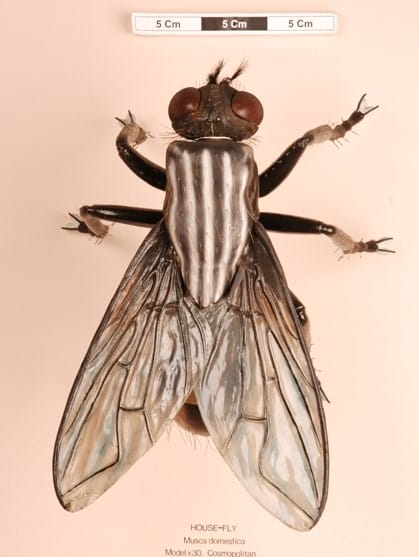Are flies endangered?
It will probably surprise you to hear that the house fly is critically endangered.
Insect populations across the world are depleting, particularly as the use of pesticides grows.
However the house fly is also thought to be the most common animal on the planet. Don’t let that make you think they’re not special in their own way; humans are also seemingly everywhere and we all have a few of those we think are pretty great.
The house fly may be numerous, and irritating at picnics, and yes, they can carry many disease-causing pathogens including typhoid, cholera, and leprosy, but they have many upsides too.

How do flies solve murder?
If CSI Miami was made into a cartoon with insect characters, the house fly would definitely be the cool-guy crime scene investigator. The discipline of Forensic Entomology uses insects and the stages of their development to glean clues from fatal crime scenes that can aid legal investigations.
If the body is found immediately after death, pathology-based methods are used. However, if the body isn’t found until a day or more later, insects are one of the most reliable indicators of many aspects of the crime.
The decomposition of a body can be split into five phases. Just in case you’re reading this over dinner, I shan’t use the precise medical terms, but they are as follows:
- Could be sleeping (1-2 days)
- Resembles a flotation device (2-6 days)
- Nose peg required before approach (7-12 days)
- Starting to become part of the environment (13-23 days)
- Could be in a museum (24 days onwards)
Flies appear at a dead body very quickly. Some particularly well-organised and highly motivated species detect the expiration and land within minutes.
As different insects arrive at the different stages listed above, a forensic scientist can use a survey of the species present, and the point at which they are within their life cycle, to accurately establish how long ago the unfortunate person began sleeping with the fishes. Our humble house fly is never late to dinner. It likes to get there early in the event, and will land at the point the cadaver starts to resemble a flotation device.
Are flies useful?
We produce so much rubbish that entire ecosystems of wildlife are able to live in urban areas. You just need a bank holiday to realise how much we rely on refuse collectors and their trash-squishing trucks.
Whilst bin boys and girls kindly collect our rubbish and hide it away where we can conveniently forget about how much food we ate over the weekend, it takes other much smaller members of the animal kingdom than humans to break it down.
The housefly is amongst those that aid the decay of organic matter and with every fly that vomits onto the waste food in order to digest it, these insects elegantly ensure our food waste is re-harnessed by the natural circle of life.
Thank you flies.


